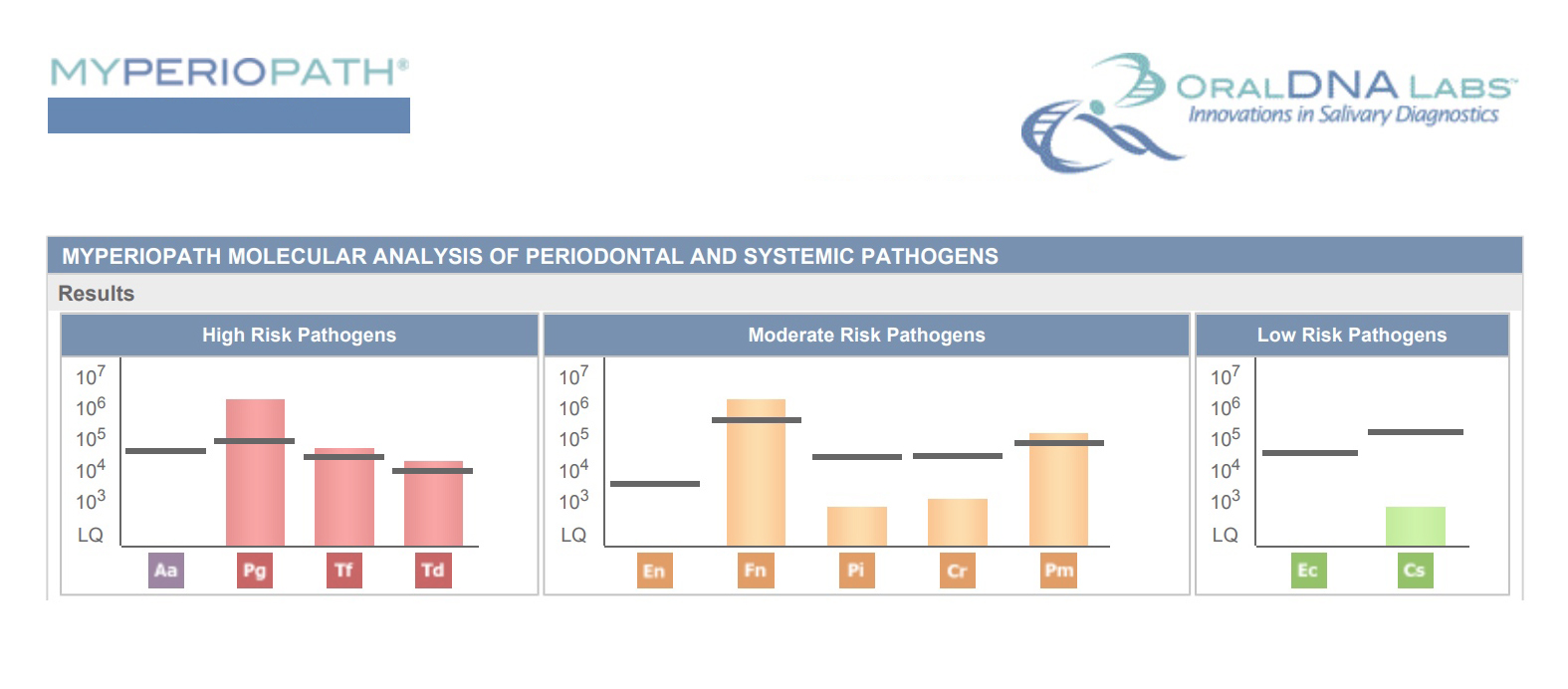
In a previous blog, Salivary Diagnostics—Your Molecular X-ray, I introduced the concept of using salivary diagnostics to provide objective understanding to the clinical signs observed with periodontal disease. Once a saliva specimen is analyzed and the results released, the clinician must correlate the lab results to the clinical signs, and decide the next steps for treatment. One feature of the MyPerioPath® test report is the “Therapeutic Thresholds”, displayed as black lines overlying the bars which represent the measure of each bacteria assayed. This blog will provide the origins of those Therapeutic Thresholds, and how clinicians should consider the results of each patient, relative to those levels. It will also explain the role these Therapeutic Thresholds play with systemic antibiotic suggestions and review an alternative option to Therapeutic Thresholds for consideration.
The Basis of the Therapeutic Thresholds: The Therapeutic Thresholds represent the respective level of bacteria associated with moderate/severe chronic periodontitis calculated from an extensive sampling of clinically confirmed patients exhibiting bleeding 4-5 mm periodontal pockets. Patient results representing varying backgrounds/situations were analyzed. The Therapeutic Thresholds represent a midpoint of the amount of bacteria correlated with a certain severity of clinical disease. The statistical power of these analyses is extraordinary and reliable.
Other Risk Factors and the True Threshold: Deciding who and how to treat is ultimately based on clinical findings and determined by the treating healthcare professional. The Therapeutic Threshold displayed on each result report should be a guidepost to ask what other parts of this patients health might raise or lower the black lines, reflecting their personal and true thresholds? Diabetes is one obvious systemic risk factor that is likely to decrease the patient’s true threshold. Smoking is another. In both cases there is the altering of the person’s immune function that gives rise to the clinical signs of inflammation and chronic effects of tissue damage with lesser levels of these key pathogens. Genetic susceptibility manifests greater than needed levels of chronic inflammation, also possibly lowering the patient’s true or personal threshold. There are several genetic salivary tests for the clinician to consider for objective and concrete information regarding a patient’s genetic risk, such as MyPerioID® IL-6 (part of Alert 2™) and Celsus One™. This is a limited list of other risk factors that may impact the patient’s true threshold. For this reason, a complete review of the medical history with each patient is always the standard of care, and critical to uncover other important risk factors.
The Systemic Antibiotic Selection: The Therapeutic Thresholds are not the basis by which a clinician should choose to use an antibiotic. Rather, the black lines on each MyPerioPath® report serve as an indicator of a consensus regimen for the selection of which antibiotic to prescribe. When there is a single bacteria, or combination of bacteria, above the therapeutic threshold line, an antibiotic(s) selection will be inserted in the Treatment Considerations section of the report. If the bacteria are present but below the threshold, a resource called MyPerioPath® Antibiotic Options, is available for the clinician to determine the most appropriate antibiotic option(s).
Alternative to Therapeutic Threshold: Some clinicians prefer to base treatment options on total bacterial load rather than Therapeutic Thresholds. In these cases, there is an option when ordering the MyPerioPath® or Alert 2™ to have the threshold lines removed from the lab report. If the option for removal is selected, the systemic antibiotic option is still based off of the Therapeutic Thresholds, and an antibiotic selection will appear only when levels exceed the threshold.
Just as with any medical lab report which shows the reference range for the particular test result, the Therapeutic Thresholds, serve as a reference range for clinical decision-making. Bacteria reported above the Therapeutic Thresholds might be viewed as out of range, while bacteria detected at levels below the Therapeutic Thresholds may be considered as in range.
For more information on how to become an OralDNA Provider – scan HERE: 
- Practicing Dental Medicine: The Partnership with a Clinical Laboratory - December 13, 2024
- Olympic Spirit: Achieving Gold in Healthcare - August 16, 2024
- The Winning Team: The Healthcare Provider & The Clinical Laboratory - April 12, 2024
